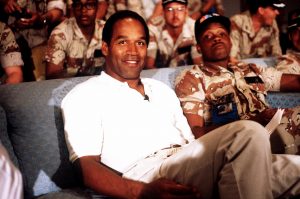Standard Of Review: 'O.J. Simpson: Made in America' Just May Be The Best O.J.-Related Programming Of 2016
O.J.: Made in America is long but well worth your time, according to TV critic Harry Graff.

O.J. Simpson (via Wikimedia)
After viewing and writing about the excellent ten-part FX miniseries The People v. O.J. Simpson: American Crime Story earlier this year, I did not think I could stomach any more Simpson-related programing. I was wrong. The five-part ESPN documentary series O.J.: Made in America, which premiered last week, is comprehensive, riveting, and utterly fantastic. This is a must-watch.
Directed by Ezra Edelman, O.J.: Made in America depicts every aspect of Simpson’s life, including his upbringing, his football career, his many television and film appearances, his tenure as a pitchman for Hertz, the complicated racial politics of Los Angeles, his relationship with Nicole Brown, his legal team, and his murder trial. The first three episodes aired within the past week, with parts four and five airing this weekend (this column will focus on – and contain spoilers for, to the extent a documentary of twenty-year old events can be spoiled – the first three episodes).

How Thomson Reuters Supercharged CoCounsel With Gen AI Advances

One of my criticisms of The People v. O.J. Simpson was that it failed to show why Simpson was so beloved and had such broad mainstream appeal. Throughout that series, Cuba Gooding Jr. plays Simpson as perpetually brooding, a far cry from the Simpson that America knew as a multi-platform star. Surely, Simpson was probably not particularly gregarious during his murder trial, but The People v. O.J. Simpson should have depicted more of Simpson’s pre-murder trial life in order to underscore the contrast.
O.J.: Made in America does not fall into that trap. The series spends almost two episodes on Simpson’s life before the trial. It depicts Simpson’s ease in front of the camera, which enabled him to become more than just a football star. There are numerous interviews with former Hertz CEO Frank Olson, who describes the genesis of Simpson’s famous Hertz commercials. Film director David Zucker discusses Simpson’s role as Detective Norberg in one of my favorite comedies of all time, The Naked Gun.
But beneath the veneer of Simpson’s outward personality, the film details Simpson’s relationship with Nicole Brown. Simpson met Brown when he was still married to his first wife, and it was a storybook romance on the surface. But, troublingly, one of Brown’s friends describes how she came back from her first date with Simpson with torn jeans due to the fact that Simpson was “a little forceful.” After Simpson and Brown marry, the tumult continues, as Simpson repeatedly beats her. Edelman plays Brown’s 911 calls in their entirety, which are horrifying to hear after knowing what ends up happening to her. Brown’s boyfriend after separating from Simpson describes an encounter with Simpson that perfectly encapsulates Simpson’s personality; Simpson angrily berates Brown (and reveals that he watched Brown and her boyfriend have sex) and then turns on a dime, smiling, shaking her boyfriend’s hand and apologizing for troubling him.
Further, the series excels in delving deep into the racial politics of Los Angeles, including the Watts riots, the Rodney King riots, the death of Latasha Harlins, and the attack on Reginald Denny. The documentary does not have an obvious political bent; for example, he includes interviews with black activists as well as white police officers who defend the policemen that beat King.
Sponsored

How Thomson Reuters Supercharged CoCounsel With Gen AI Advances


Data Privacy And Security With Gen AI Models

Legal Contract Review in Under 10 Minutes? Here’s How

Curbing Client And Talent Loss With Productivity Tech
Edelman spends so much time on that history of race in Los Angeles because it is is crucial to understanding Simpson’s story. Simpson eschewed the activism of other black athletes such as Kareem Abdul-Jabbar, Muhammad Ali, Tommie Smith, or John Carlos. Indeed, Simpson once rebuffed requests by black leaders by stating “I’m not black, I’m O.J.” Simpson was not the only person to think that; journalist Zoey Tur – who, in one of the highlights of the film, recounts how her news helicopter located Simpson’s white Bronco during the infamous police chase – states that “if O.J. Simpson were black that [expletive] wouldn’t have happened.” Former Hertz CEO Olson states that to him, Simpson was “colorless,” even though he disturbingly describes how Hertz included white children chanting “go O.J. go” during his famous Hertz commercial in order to comfort white Americans.
The third episode, in which Simpson’s legal team is assembled and the trial begins, will be of particular interest to lawyers. Carl E. Douglas, Johnnie Cochran’s protege, is the surrogate for the late Cochran, explaining the defense’s strategy. Douglas is a true raconteur, telling stories about the defense in extremely entertaining fashion. For example, Douglas describes how after Judge Lance Ito ordered that the jury should go on a tour of Simpson’s home, the defense re-arranged Simpson’s photographs and paintings in order to make it appeal to the predominantly African-American jurors; among other things, the defense removed pictures of Simpson with white celebrities such as Donald Trump and instead inserted the famous Norman Rockwell painting The Problem We All Live With from Cochran’s office. Douglas amusingly explains that after prosecutor Marcia Clark complained, the defense feigned indignation to Judge Ito that Clark would stoop to such accusations. Also, like The People v. O.J. Simpson, O.J.: Made in America is harsh on Robert Shapiro (who does not appear for an interview), portraying him as a celebrity lawyer who was unfit for such a large and complicated trial.
On the prosecution side, Clark and former district attorney Gil Garcetti are prominently featured. The series portrays Clark as a dogged prosecutor who is very skilled her job. She is still fuming about some of the defense team’s tactics, such as the aforementioned photograph swap. The series also spends a lot of time on the Garcetti’s decision not to ask the judge to move the trial outside Los Angeles County, which resulted in a predominantly non-white jury.
O.J.: Made in America is long but well worth your time. Literally the only criticism I have is that the theme song sounds disturbingly like the theme to Homeland; every time I hear it, I half expect Mandy Patinkin to show up eating peanut butter with a ruler. Next week I will discuss the fourth and fifth episodes, which further delve into Simpson’s trial and its aftermath. In the meantime, somebody better greenlight another Simpson-related show stat – I cannot get enough.
Sponsored

Tackling Deposition Anxiety: How AI Is Changing The Way Lawyers Do Depositions

Curbing Client And Talent Loss With Productivity Tech
Harry Graff is a litigation associate at a firm, but he spends days wishing that he was writing about film, television, literature, and pop culture instead of writing briefs. If there is a law-related movie, television show, book, or any other form of media that you would like Harry Graff to discuss, he can be reached at [email protected]. Be sure to follow Harry Graff on Twitter at @harrygraff19.







